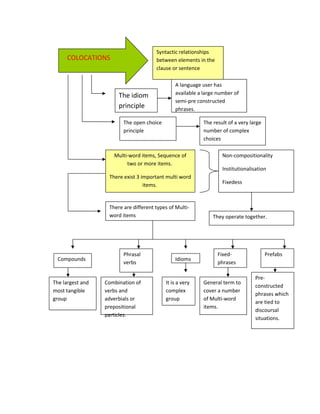
Cmap multi word items
- 1. Syntactic relationships COLOCATIONS between elements in the clause or sentence A language user has The idiom available a large number of semi-pre constructed principle phrases. The open choice The result of a very large principle number of complex choices Multi-word items, Sequence of Non-compositionality two or more items. Institutionalisation There exist 3 important multi word Fixedess items. There are different types of Multi- words. word items They operate together. Phrasal Fixed- Prefabs Compounds Idioms verbs phrases Pre- The largest and Combination of It is a very General term to constructed most tangible verbs and complex cover a number phrases which group adverbials or group of Multi-word are tied to prepositional items. discoursal particles. situations.
- 2. Traditions and models Semantic-based model Syntax-based model First generation: One To examine lexis in a million words Corpus evidence more scientific and Second generation: objective way. Twenty million words Variability British/American Multi-word ítems are presented as a problem Varying in teaching a foreign Stylistic errors lexical language component. Pragmatic errors Unstable verbs. Truncati Formal errors on. Transforma tion. Teaching multi-word ítems Pedagogical techniques The use of short To choose topics dialogues on the basis of frecuency, need, transparency etc.